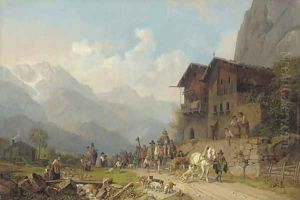Heinrich Butrkel Paintings
Heinrich Bürkel was a German painter, born on September 16, 1802, in Pirmasens, a small town in the Rhineland-Palatinate region of Germany. He is best known for his realistic and detailed landscapes as well as genre scenes depicting rural life, which were prevalent themes throughout his career. Bürkel showed an early interest in art and began to pursue his passion for painting despite the lack of formal art education in his hometown.
In his pursuit of artistic training, Bürkel moved to Munich in 1823, which was a significant center for art in Germany at the time. There, he became associated with the Munich School, a group of like-minded artists who were committed to painting in a style that emphasized detailed realism and often romantic elements. Bürkel did not enroll in the Academy of Fine Arts but instead learned by copying the works of Dutch and Flemish masters. He was particularly influenced by the 17th-century Dutch genre and landscape painters, whose work would have a lasting impact on his own painting style.
By the 1830s, Heinrich Bürkel had established himself as a successful artist. His works were appreciated for their lively depiction of everyday scenes, often imbued with a sense of humor and keen observation of social interactions. Peasants, travelers, and animals were frequently the subjects of his paintings. Bürkel's landscapes and genre scenes were not only popular in Germany but also gained recognition abroad, particularly in the United States.
Throughout his career, Bürkel remained in Munich, though he traveled extensively for inspiration. His travels took him to Italy, where he was deeply impressed by the landscape and the quality of light, elements that would feature prominently in his later works. Despite the trend toward Romanticism in the 19th century, Bürkel maintained his detailed and realistic style, which appealed to a wide audience. He exhibited regularly at the Munich Art Exhibition and also became a member of the Munich Artists' Association.
Heinrich Bürkel died on June 10, 1869, in Munich. His legacy includes a large body of work that continues to be appreciated for its realistic portrayal of 19th-century rural life. Bürkel's paintings can be found in various museums and private collections, providing a window into the past through his detailed and lifelike representations of the landscapes and the people of his time.
